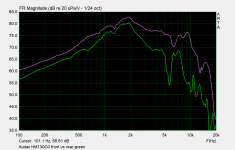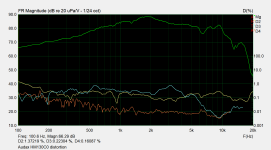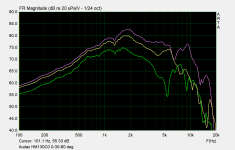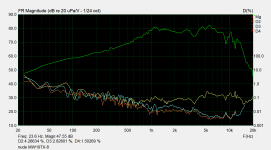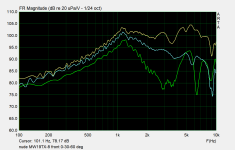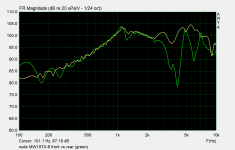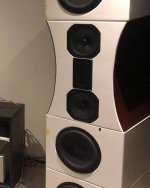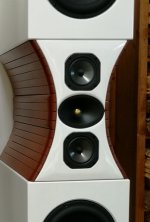This driver is not bad. I measured it as a nude midrange a couple of years back. The FR is usable, but it definitely has higher distortion than the SB17MFC. See attached measurements of front on and off axis, harmonic distortion, and front vs rear (0 vs 180deg) frequency response.I like the Audax HM170CO for all sort of midrange applications, even OB. The midrange upper end is excellent up past 4k with its highly controlled, gradual breakup and good sensitivity.
For comparison I am also posting my measurements under similar test conditions of a nude SB17MFC. IMHO the FR is smoother and stays together from 1k to 4k compared to the Audax.
I also measured this driver and used it in a system once, but I cannot find the measurements data now. IIRC distortion was relatively low but FR not as smooth as either the Audax HM170 or the SB17MFC. I am glad that Peerless is resuming production of this driver and it will or should again be available for DIY purchases.and the Peerless NE180W.
Attachments
-
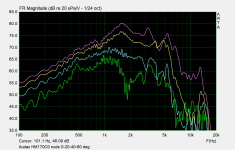 Audax HM170C0 nude 0-20-40-60 deg.png70.4 KB · Views: 56
Audax HM170C0 nude 0-20-40-60 deg.png70.4 KB · Views: 56 -
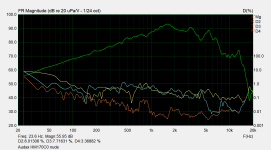 Audax HM170C0 nude distortion.png103.3 KB · Views: 58
Audax HM170C0 nude distortion.png103.3 KB · Views: 58 -
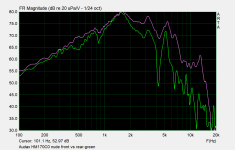 Audax HM170C0 nude front vs rear-green.png59 KB · Views: 53
Audax HM170C0 nude front vs rear-green.png59 KB · Views: 53 -
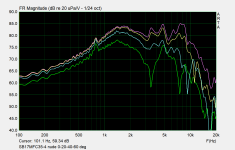 SB17MFC35-4 nude 0-20-40-60 deg.png64.8 KB · Views: 60
SB17MFC35-4 nude 0-20-40-60 deg.png64.8 KB · Views: 60 -
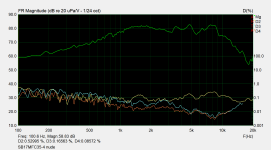 SB17MFC35-4 nude distortion.png89 KB · Views: 59
SB17MFC35-4 nude distortion.png89 KB · Views: 59 -
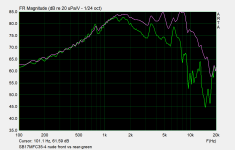 SB17MFC35-4 nude front vs rear-green.png57.4 KB · Views: 53
SB17MFC35-4 nude front vs rear-green.png57.4 KB · Views: 53
Last edited:
While we are talking drivers and nude midranges in particular, another good one is the little Audax HM130C0. FR is great in that application (beautifully controlled cone breakup!), and only the distortion performance is a little worse than other drivers (it has the same motor design as the HM170). It is a 5.25" class driver, so it can work a bit higher in frequency when used nude, but on the low side should probably be crossed over around 700Hz. So the next driver down in frequency must be able to crosso over that high. For comparison, I use a 6.5" class driver down to 350Hz and this makes is possible to build a 3-way dipole speaker, whereas the 5.25" drivers probably must be used in a 4-way system.
See attached plots. For the front vs rear plot, I forgot to match the levels but you get the idea. The driver is built like a tank and is not all that expensive. Looks cool, too.
See attached plots. For the front vs rear plot, I forgot to match the levels but you get the idea. The driver is built like a tank and is not all that expensive. Looks cool, too.
Attachments
@CharlieLaub Those are interesting measurements. The last time I measured the HM170CO, it was lower in HD than your data. That was likely due to the baffle size (or lack of it in your case). Its also possibly due to more of the driver being exposed, with the entire chassis contributing to the measured response, "warts and all".
Many drivers emit all sorts of weirdness when the entire chassis backside is exposed. Because these aren't necessarily the conditions a manufacturer intends for their driver to operate under, its going to show some increase in HD compared to a driver measured in an infinite baffle with the microphone placed and listening only at the front (cone axis) of the driver.
Many drivers sound quite bad when being listened to from the front with the entire chassis being exposed ie. smaller open baffle arrangement. This is specifically the case at lower frequencies, where much of the fundamental LF range of the driver is being canceled out from the lack of an enclosure or large enough baffle. This ends up with a higher percentage of "junk" being left over, mainly distortion laden harmonics.
Drivers like the majority of the Peerless NE series are unicorns. They have exceptionally low levels of HD, often less than far more expensive drivers that are equipped with far less fancy motors. The Audax CO drivers sound very natural and effortless in standard box style speaker or even a large open baffle design. They do lack some distortion lowering features but sound natural and "correct" to my ears at the circumstances I've used them under. This is why I always say HD measurements on their own aren't showing the entire picture of a driver's capability to deliver very good overall fidelity or tasteful presentation of music.
Many drivers emit all sorts of weirdness when the entire chassis backside is exposed. Because these aren't necessarily the conditions a manufacturer intends for their driver to operate under, its going to show some increase in HD compared to a driver measured in an infinite baffle with the microphone placed and listening only at the front (cone axis) of the driver.
Many drivers sound quite bad when being listened to from the front with the entire chassis being exposed ie. smaller open baffle arrangement. This is specifically the case at lower frequencies, where much of the fundamental LF range of the driver is being canceled out from the lack of an enclosure or large enough baffle. This ends up with a higher percentage of "junk" being left over, mainly distortion laden harmonics.
Drivers like the majority of the Peerless NE series are unicorns. They have exceptionally low levels of HD, often less than far more expensive drivers that are equipped with far less fancy motors. The Audax CO drivers sound very natural and effortless in standard box style speaker or even a large open baffle design. They do lack some distortion lowering features but sound natural and "correct" to my ears at the circumstances I've used them under. This is why I always say HD measurements on their own aren't showing the entire picture of a driver's capability to deliver very good overall fidelity or tasteful presentation of music.
Last edited:
On a roll now... another GREAT driver for a nude midrange despite it being a bit larger is the SB Acoustic MW19TX. It offers low distortion, decent FR extension up top as high as 4kHz where it is in a well controlled cone breakup, and the front and rear responses are nearly identical to almost 2.5kHz except for a small blip in the rear response around 1.2kHz. Because of its greater Sd and Xmax being 6.5mm you can use it even lower when nude and or get higher playback SPL before the driver sounds stressed. IIRC distortion starts to climb only once you get below 250Hz or so. See attached measurements.
I will be using this driver again, when ever I finally get back into speaker building here.
I will be using this driver again, when ever I finally get back into speaker building here.
Attachments
@CharlieLaub I totally agree with you about the HM130CO. It makes a fantastic cone mid with decent sensitivity and low level detail retrieval. I spoke with a rep from Audax back in the 80s and asked them about the design strategies they set for the carbon fiber woven cone HMxxxCO series. They commented that not having to rely on induction control measures on these drivers helped retain more base sensitivity. Most people don't understand that using shorting rings in the motor actually reduces sensitivity. This is due to the dampening losses shorting rings create along with the increased VC gap width needed to fit them, reducing gap flux density). So, together with the careful motor design, using flat profile VC wire and not relying on shorting rings, they retained a higher BL factor. This gives you a stronger, lower loss motor without most of the bad side effects from oversizing it.
Thanks for providing the measurements!!While we are talking drivers and nude midranges in particular, another good one is the little Audax HM130C0. FR is great in that application (beautifully controlled cone breakup!), and only the distortion performance is a little worse than other drivers (it has the same motor design as the HM170). It is a 5.25" class driver, so it can work a bit higher in frequency when used nude, but on the low side should probably be crossed over around 700Hz. So the next driver down in frequency must be able to crosso over that high. For comparison, I use a 6.5" class driver down to 350Hz and this makes is possible to build a 3-way dipole speaker, whereas the 5.25" drivers probably must be used in a 4-way system.
See attached plots. For the front vs rear plot, I forgot to match the levels but you get the idea. The driver is built like a tank and is not all that expensive. Looks cool, too.
Nice driver, as you wrote, but 700Hz xo won't work with my midbass section.
BTW, I'm doing 4 ways:
4 sealed subs (12" Rythmiks in DIY boxes) up to 60Hz
SLOB with 8x 6.5" up to 470Hz
B&C 8PE21 on a 12" open baffle up to 1.1kHz
Beyma TPL-150H open back
In an active setup using Acourate for xo and filters, so linearphase steep xo are easy to do.
For now I'm considering the subs and midbass "done". Looking to improve midrange and tweeter. So the midrange needs to xo at 470Hz max.
Thank you.
I wasn't aware of these. I recall you purchased LM10n. How did you like them?
Have you had good references about ER 505? I went through their website, read all customer examples shown. All seemed to use middle of the road electronics and used that huge panel for mids and tweeter. Makes me wonder.
The LM10N are exactly what you expect. A well built, incremental improvement of Igor's designs for BG. As such, they are still my go to driver for clean, precise sounding midrange. Obviously, not as easy to wrangle into a flat response as good cone drivers, but worth the effort in an active system. As you mentioned, Igor is now using them in his own design. Down to 250hz even for a single unit. I'd think, as the drivers designer, he knows best what they can actually handle. I'm still planning on a similar crossover point, but my use case will be much lower max spl due to the ultra nearfield design for my chair based system.
Thanks @studiotech
After the last comment about limitations of plannars I checked the specs on Levitsky's Consonus Tide design: Max SPL is 114dB short-term (pink noise at 1m) and 120dB peak. This is with LM10n playing from 250Hz.
Yet @cowanaudio has extensive experience designing speakers, used the smaller LM8K in an array from 400Hz, and said these don't have sufficient displacement to achieve my desired xo point (somewhere in the 400 to 470Hz).
Can anybody think of a way to figure this out, short of buying and testing the drivers?
After the last comment about limitations of plannars I checked the specs on Levitsky's Consonus Tide design: Max SPL is 114dB short-term (pink noise at 1m) and 120dB peak. This is with LM10n playing from 250Hz.
Yet @cowanaudio has extensive experience designing speakers, used the smaller LM8K in an array from 400Hz, and said these don't have sufficient displacement to achieve my desired xo point (somewhere in the 400 to 470Hz).
Can anybody think of a way to figure this out, short of buying and testing the drivers?
Thanks for pointing to this driver, and for including your measurements!On a roll now... another GREAT driver for a nude midrange despite it being a bit larger is the SB Acoustic MW19TX. It offers low distortion, decent FR extension up top as high as 4kHz where it is in a well controlled cone breakup, and the front and rear responses are nearly identical to almost 2.5kHz except for a small blip in the rear response around 1.2kHz. Because of its greater Sd and Xmax being 6.5mm you can use it even lower when nude and or get higher playback SPL before the driver sounds stressed. IIRC distortion starts to climb only once you get below 250Hz or so. See attached measurements.
I will be using this driver again, when ever I finally get back into speaker building here.
Indeed, a very good looking driver.
After reading HiFiCompass on MX19TX, PTT6.5M08-NFA-01, SB17MFC35-4, I'm thinking the SB is a very nice driver but performing a step below the other two maybe because it's a bit older design.
The MX19TX looks very good. As you mentioned, clearly allows for a lower xo point (that I won't benefit from), and dispersion past 2kHz might not allow for good integration to a tweeter. Distortion levels on par with PTT6.5M08 that is referred to as top end in this regard.
I wonder how 2 x the 5,25" 92 dB Audax HM130Z0 would have worked in OB, maby the superthin aerogel-cone will create a fantastic ambience/omnidirectional soundstage.For now I'm considering the subs and midbass "done". Looking to improve midrange and tweeter. So the midrange needs to xo at 470Hz max.
Or 2 x the 8" 98 dB Audax HM210Z10 ?
I have use both of these in MTM with Mundorf AMT and WG twee, and its really great!
Attachments
Well, this all depends how loud you want to listen and what kind of dynamic range your music has. For most people, anything over 100dB is VERY loud. Have you ever measured for yourself how loud you listen?Thanks @studiotech
After the last comment about limitations of plannars I checked the specs on Levitsky's Consonus Tide design: Max SPL is 114dB short-term (pink noise at 1m) and 120dB peak. This is with LM10n playing from 250Hz.
Yet @cowanaudio has extensive experience designing speakers, used the smaller LM8K in an array from 400Hz, and said these don't have sufficient displacement to achieve my desired xo point (somewhere in the 400 to 470Hz).
Can anybody think of a way to figure this out, short of buying and testing the drivers?
But I would agree that the LM8K is starting to get strained below 500-600 hz. The LM10n is still fine that low.
Thank you.I wonder how 2 x the 5,25" 92 dB Audax HM130Z0 would have worked in OB, maby the superthin aerogel-cone will create a fantastic ambience/omnidirectional soundstage.
Or 2 x the 8" 98 dB Audax HM210Z10 ?
I have use both of these in MTM with Mundorf AMT and WG twee, and its really great!
Are those MTM open in the back? Must make for a quite large panel as they look deep.
I listen at 80-85dB. When I'm alone and want to crank it I might get to 95dB, but 100dB would be rare at best. My living room is 10x5 meters - not large. This is why I noted the Consonus Tide power rating as to why I'm thinking the LM10n could be loud enough.Well, this all depends how loud you want to listen and what kind of dynamic range your music has. For most people, anything over 100dB is VERY loud. Have you ever measured for yourself how loud you listen?
But I would agree that the LM8K is starting to get strained below 500-600 hz. The LM10n is still fine that low.
LM10n is rated 100W long-term mx power (IEC) and it' rated 94dB, so at 100W it would produce over 112dB SPL, so plenty loud.
But then I'm not sure about dynamic range. I don’t listen to much classical - just some. Most material I play has max 18dB dynamic range...call it 20dB.
No the mids is in closed box.Are those MTM open in the back? Must make for a quite large panel as they look deep.
But i think they will great also in a OB.
@LewinskiH01 The M142A was one of my top choices for mids that have rear emissive balance close to that of the front. I'm not claiming it has the best polar response from the rear, but what is there sounds alot like the front, which is excellent by my standards.
A big issue with OB is the way it tends to load (or not load for that matter) the diaphragm surface. That has some unpredictable effects on the entire driver's performance. The one parameter that is possibly the most important is Qts, Fs and odd order HD around Fs.
That said, I've heard some very inexpensive drivers in typical enclosures that sounded just average for a given application. However, one or another of these drivers could prove to be transformative when used in an open baffle. There was no specific rhyme or reason why this is was the case. Aside from the usual few TSPs that defined a driver as being suitable for OB use (Fs, Qts, xmax), there were a few others that were believed to be completely unrelated. The driver needs to be approached from the perspective of a totally interactive system, not just singling out specific data or parameters by themselves.
There are quite a few less obvious driver variables that can influence how a driver will subjectively perform. Various enclosures or acoustic loading schemes (ie. horn loaded, TL, sealed, etc) can produce unexpected results.
For example, I've heard drivers which had way too low Fs/Qts ratios and sounded alot better in the LF than some higher end, purpose designed drivers. In these cases, the specs didn't necessarily lie, but they created more of an expectational bias how a given driver should sound in a chosen enclosure. As opposed to this, when an (on paper) less suitable driver proves us wrong, we end up being "pleasantly surprised". Expectations have alot to do with this.
So after this long winded explanation, my synopsis is that if one person feels a specific driver isn't suitable for OB use, there will be others who feel the opposite way. My experiences with the M142A are rather limited from a measured performance perspective, but I did like very much what I heard when testing the driver with music on a large OB. Again, some of this can definitely be conformation bias, but after 35 years of doing this stuff, one tends to develop a refined sense of judgment when evaluating drivers on the fly. Your results may definitely vary, as the saying goes.
A big issue with OB is the way it tends to load (or not load for that matter) the diaphragm surface. That has some unpredictable effects on the entire driver's performance. The one parameter that is possibly the most important is Qts, Fs and odd order HD around Fs.
That said, I've heard some very inexpensive drivers in typical enclosures that sounded just average for a given application. However, one or another of these drivers could prove to be transformative when used in an open baffle. There was no specific rhyme or reason why this is was the case. Aside from the usual few TSPs that defined a driver as being suitable for OB use (Fs, Qts, xmax), there were a few others that were believed to be completely unrelated. The driver needs to be approached from the perspective of a totally interactive system, not just singling out specific data or parameters by themselves.
There are quite a few less obvious driver variables that can influence how a driver will subjectively perform. Various enclosures or acoustic loading schemes (ie. horn loaded, TL, sealed, etc) can produce unexpected results.
For example, I've heard drivers which had way too low Fs/Qts ratios and sounded alot better in the LF than some higher end, purpose designed drivers. In these cases, the specs didn't necessarily lie, but they created more of an expectational bias how a given driver should sound in a chosen enclosure. As opposed to this, when an (on paper) less suitable driver proves us wrong, we end up being "pleasantly surprised". Expectations have alot to do with this.
So after this long winded explanation, my synopsis is that if one person feels a specific driver isn't suitable for OB use, there will be others who feel the opposite way. My experiences with the M142A are rather limited from a measured performance perspective, but I did like very much what I heard when testing the driver with music on a large OB. Again, some of this can definitely be conformation bias, but after 35 years of doing this stuff, one tends to develop a refined sense of judgment when evaluating drivers on the fly. Your results may definitely vary, as the saying goes.
I don't know about putting speakers on springs. Considering all of the people who can hear Doppler effects, cable effects, and differences between different hundred dollar capacitors, I think it's a really bad idea to suspend a vibrating system on a suspension that is itself prone to vibrate. It's like a 1958 VW Beetle. Also, who hasn't bounced a woofer on the workbench by sending a large signal through it? The same Newtonian forces are at work here.I use Mundorf AMT 25D1.1 for tweeter.
I use no baffle for PTT6.5M, instead mounting it to open frame using spring. I borrow the idea from one company in Netherlands. Mounting it in no-baffle help extend the dipole effect to higher frequency.
View attachment 1456374
@Arthur Jackson Yours is a common misconception. I did an analysis of this kind of system for a paper I published a year or two ago in audioXpress on nude open baffle systems, where the drivers are suspended and freely hanging using wires. There is really only 1D motion taking place along the axis through which the voice coil is moving. What happens is that when the motor force pushes on the cone, they actually are pushing each other apart since there is no "anchor" between the frame and the ground e.g. via a cabinet. But since the motor and non moving parts outweigh the cone VC and VC former by many times, the amount of motion of each is very, very lopsided such that in reality the frame hardly moves at all. The movement of the frame is opposite to that of the cone, so it slightly subtracts from the cone's movement and causes a loss of SPL, however, these losses are much less than 1dB. I actually calculate them for the SB17MFC and the loss is only 0.07dB. Also, the losses are 100% linear and there is no doppler effect because the same motion is happening in the frame as is happening in the cone, just in opposite directions.
Doppler distortion can only take place when one signal modifies/modulates a different one, and they are typically of very different frequencies. That is not what is happening with a freely suspended driver.
In other words: no worries, it's all good.
Doppler distortion can only take place when one signal modifies/modulates a different one, and they are typically of very different frequencies. That is not what is happening with a freely suspended driver.
In other words: no worries, it's all good.
Totally agree but hard to explain, not very intuitive, rather counterintuitive, the best driver do not give you necessarily best result in OB, to make the story short.A big issue with OB is the way it tends to load (or not load for that matter) the diaphragm surface. That has some unpredictable effects on the entire driver's performance. The one parameter that is possibly the most important is Qts, Fs and odd order HD around Fs.
That said, I've heard some very inexpensive drivers in typical enclosures that sounded just average for a given application. However, one or another of these drivers could prove to be transformative when used in an open baffle. There was no specific rhyme or reason why this is was the case. Aside from the usual few TSPs that defined a driver as being suitable for OB use (Fs, Qts, xmax), there were a few others that were believed to be completely unrelated. The driver needs to be approached from the perspective of a totally interactive system, not just singling out specific data or parameters by themselves.
There are quite a few less obvious driver variables that can influence how a driver will subjectively perform. Various enclosures or acoustic loading schemes (ie. horn loaded, TL, sealed, etc) can produce unexpected results.
And as you wrote we should consider the entire system too.
I would like to see data where the woofers play a transient of substantial energy and the spring system does not oscillate or ring. I made the comment on Doppler because the effect is a very small phase change, I think the effect of suspending a loudspeaker on springs can be quite large and even visible with a large enough signal. Also, they HAVE to ring sympathetically. It's physics. During large transients my loudspeakers will induce my piano and guitars to ring, so suspending loudspeakers on springs will behave the same way. The speaker will vibrate harmonically with any amount of power input. The music sent to the speaker is a complex wave and some of that wave will be traveling reverse of the lower frequency wave, it's not just a loss it's a phase change too.@Arthur Jackson Yours is a common misconception. I did an analysis of this kind of system for a paper I published a year or two ago in audioXpress on nude open baffle systems, where the drivers are suspended and freely hanging using wires. There is really only 1D motion taking place along the axis through which the voice coil is moving. What happens is that when the motor force pushes on the cone, they actually are pushing each other apart since there is no "anchor" between the frame and the ground e.g. via a cabinet. But since the motor and non moving parts outweigh the cone VC and VC former by many times, the amount of motion of each is very, very lopsided such that in reality the frame hardly moves at all. The movement of the frame is opposite to that of the cone, so it slightly subtracts from the cone's movement and causes a loss of SPL, however, these losses are much less than 1dB. I actually calculate them for the SB17MFC and the loss is only 0.07dB. Also, the losses are 100% linear and there is no doppler effect because the same motion is happening in the frame as is happening in the cone, just in opposite directions.
Doppler distortion can only take place when one signal modifies/modulates a different one, and they are typically of very different frequencies. That is not what is happening with a freely suspended driver.
In other words: no worries, it's all good.
I think if you were to get rid of the springs and the mounting ring and instead used clamps or glued pipes to the back of the motors you would notice an increase in clarity because the woofers won't be swinging around and the springs won't be ringing.
Having said that, the effect may be imperceptible by humans. If so, then Doppler is also imperceptible and speaker cables of reasonable quality are too.
- Home
- Loudspeakers
- Multi-Way
- Top midrange drivers for open baffle?
